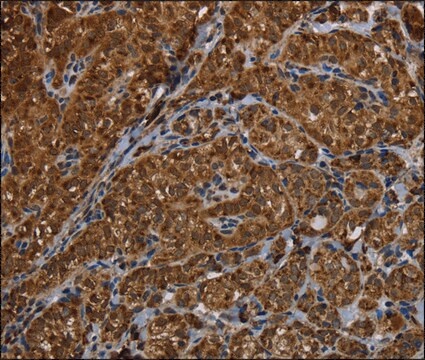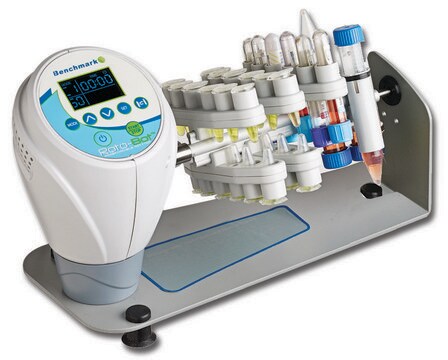Descrição geral
We are committed to bringing you greener alternative products, which adhere to one or more of the 12 Principles of Green Chemistry. This antibody is preservative-free, produced without the harm or sacrifice of animals and exceptionally stable to allow for ambient shipping and storage if needed, and thus aligns with "Waste Prevention", "Designing Safer Chemicals" and "Design for Energy Efficiency".
Click here for more information.
ZooMAb® antibodies represent an entirely new generation of recombinant monoclonal antibodies. Each ZooMAb® antibody is manufactured using our proprietary recombinant expression system, purified to homogeneity, and precisely dispensed to produce robust and highly reproducible lot-to-lot consistency. Only top-performing clones are released for use by researchers. Each antibody is validated for high specificity and affinity across multiple applications, including its most commonly used application. ZooMAb® antibodies are reliably available and ready to ship when you need them.
Especificidade
Clone 2B3 is a ZooMAb® rabbit recombinant monoclonal antibody that detects 17-β-hydroxysteroid dehydrogenase 13 (HSD17B13). It targets an epitope within 15 amino acids in the N-terminal half.
Imunogênio
KLH-conjugated linear peptide corresponding to 15 amino acids within the N-terminal half of human 17- β-hydroxysteroid dehydrogenase 13 (HSD17B13).
Aplicação
Quality Control Testing
Evaluated by Western Blotting in HepG2 cell lysate.
Western Blotting Analysis: A 1:10,000 dilution of this antibody detected HSD17B13 in HepG2 cell lysate.
Tested Applications
Western Blotting Analysis: A 1:10,000 dilution from a representative lot detected HSD17B13 in lysate from U251 cells and Human liver tissue and 1:1,000 dilution in Mouse pancreas tissue..
Immunocytochemistry Analysis: A 1:100 dilution from a representative lot detected HSD17B13 in HepG2 cells.
Affinity Binding Assay: A representative lot of this antibody bound HSD17B13 peptide with a KD of 1.0 x 10-12 in an affinity binding assay.
Immunohistochemistry (Paraffin) Analysis: A 1:1,000 dilution from a representative lot detected HSD17B13 in Human liver tissue sections.
Note: Actual optimal working dilutions must be determined by end user as specimens, and experimental conditions may vary with the end user.
Descrição-alvo
17-beta-hydroxysteroid dehydrogenase 13 (UniProt: Q7Z5P4) is encoded by the HSD17B13 gene (Gene ID: 345275) in human. It is a member of 17-beta-hydroxysteroid dehydrogenase subfamily of the short-chain dehydrogenase/reductase (SDR) superfamily. It is a single-pass transmembrane protein that is reported to reside in lipid droplets and the active site found in the cytosol. The protein contains several conserved domains, including a lipid droplet targeting motif, a cofactor-binding motif called the Rossmann fold and an active site for catalyzing the redox reactions involved in its enzymatic activity. It plays a role in hepatic lipid homeostasis. A HSD17B13 splice variant (rs72613567:TA) associated with reduced risk of nonalcoholic and alcoholic liver disease and a lower risk of nonalcoholic steatohepatitis due to an unstable truncated protein product. It is primarily expressed in liver. Altered expression of HSD17B13 has been observed in hepatocellular carcinoma tissues. HSD17B13 gene expression results show upregulation in patients with non-alcoholic fatty liver disease. This ZooMAb® recombinant monoclonal antibody, generated by our propriety technology, offers significantly enhanced specificity, affinity, reproducibility, and stability over conventional monoclonals. (Ref: Tsachaki, M. and Odermatt, A. (2019), Mol. and Cell. Endocrinol. 489, 98-106; Abul-Husn et al., (2018) N. Engl. J. Med. 378, 1096-1106)
forma física
Purified recombinant rabbit monoclonal antibody IgG, lyophilized in PBS with 5% Trehalose, normal appearance a coarse or translucent resin. The PBS/trehalose components in the ZooMAb formulation can have the appearance of a semi-solid (bead like gel) after lyophilization. This is a normal phenomenon. Please follow the recommended reconstitution procedure in the data sheet to dissolve the semi-solid, bead-like, gel-appearing material. The resulting antibody solution is completely stable and functional as proven by full functional testing. Contains no biocide or preservatives, such as azide, or any animal by-products. Larger pack sizes provided as multiples of 25 µL.
Reconstituição
300 µg/mL after reconstitution at 25 µL per vial. Please refer to guidance on suggested starting dilutions and/or titers per application and sample type.
Armazenamento e estabilidade
Recommend storage of lyophilized product at 2-8°C; Before reconstitution, micro-centrifuge vials briefly to spin down material to bottom of the vial; Reconstitute each vial by adding 25 µL of filtered lab grade water or PBS; Reconstituted antibodies can be stored at 2-8°C, or -20°C for long term storage. Avoid repeated freeze-thaws.
Informações legais
ZooMAb is a registered trademark of Merck KGaA, Darmstadt, Germany
Exoneração de responsabilidade
Unless otherwise stated in our catalog or other company documentation accompanying the product(s), our products are intended for research use only and are not to be used for any other purpose, which includes but is not limited to, unauthorized commercial uses, in vitro diagnostic uses, ex vivo or in vivo therapeutic uses or any type of consumption or application to humans or animals.










